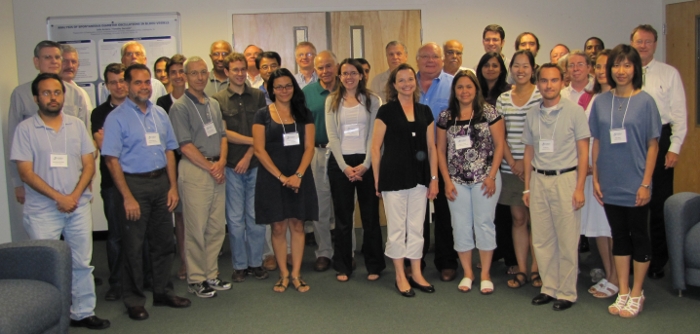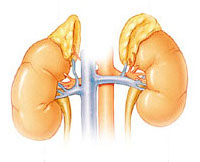| Description | Participants | Agenda | Summary | Products | Posters |
|---|
NIMBioS Investigative Workshop
Modeling Renal Hemodynamics

Topic: Mathematical Modeling and Experimental Investigations in Renal Hemodynamics
Meeting dates: August 1-3, 2011
Organizers:
Anita Layton (Dept. of Mathematics, Duke Univ.)
Leon Moore (Dept. of Physiology & Biophysics, SUNY Health Sciences Center)
Objectives: Failure of the kidneys in individuals with hypertension, diabetes, and reduced nephron number begins with deregulation of the renal microvasculature, in the form of vasodilation and reduced autoregulatory reactivity. The resulting vascular hypertrophy and capillary rarefaction give rise to nephron loss and renal microvascular injury, the extent of which depends on arterial pressure and the residual autoregulatory ability. This Investigative Workshop will bring together mathematicians, computational scientists, biologists, nephrologists, and engineers to discuss current achievements and challenges in modeling renal hemodynamics, and to identify key areas in modeling, computing, laboratory experimentation, and clinical diagnosis that could be pursued to improve our understanding of the physiology and pathophysiology of renal autoregulation and its role in the development of progressive renal diseases. The short-term goals of this workshop are to identify and address key physiological questions by facilitating the productive collaboration of interdisciplinary teams, as well as to improve existing mathematical models and generate ideas for new approaches. A long-term goal of this workshop is to integrate key data and concepts into a multi-scale mathematical model of relevant aspects of renal functions, that can be used to study how the kidney is involved in, and is impacted by, hypertension and diabetes, and how this leads to progressive renal failure.
The central theme of this workshop is to investigate, by means of modeling techniques, the potential pathogenetic link between progressive renal disease, diabetes, and hypertension. Hypertension and diabetes are epidemic in our society; their frequencies have skyrocketed among the US and overseas population in the recent decades. It is firmly established that the progression of renal microvascular injury is critically dependent upon arterial blood pressure and the extent to which autoregulatory ability is impaired. Over recent decades, a large body of experimental data has been obtained concerning the physiology and pathophysiology of the renal microvasculature, but little is known about the magnitude of blood pressure transmission into the renal microvasculature in chronic renal diseases. A goal of this workshop is to initiate the process of integrating key data and concepts into multi-scale mathematical models of the renal vasculature and hemodynamic controls, which, in the long term, can be used to study the development of hypertension, diabetes, and other progressive renal diseases.
Background reading for lecture by Anita Layton (Duke University):
Modeling the myogenic response of the afferent arteriole
Jing Chen, Ioannis Sgouralis, Leon C. Moore, Harold E. Layton and Anita T. Layton.
A mathematical model of the myogenic response to systolic pressure in the afferent arteriole.
Am J Physiol Renal Physiol 300-F669-F681, 2011.
doi:10.1152/ajprenal.00382.2010
[Online access].

Summary Report. Failure of the kidneys in individuals with hypertension, diabetes, and reduced nephron number begins with deregulation of the renal microvasculature in the form of vasodilation and reduced autoregulatory reactivity. The resulting vascular hypertrophy and capillary rarefaction give rise to nephron loss and renal microvascular injury, the extent of which depends on arterial pressure and the residual autoregulatory ability. This Investigative Workshop brought together mathematicians, computational scientists, biologists, nephrologists and engineers to discuss current achievements and challenges in modeling renal hemodynamics, and to identify key areas in modeling, computing, laboratory experimentation and clinical diagnosis that could be pursued to improve our understanding of the physiology and pathophysiology of renal autoregulation and its role in the development of progressive renal diseases. There were eight talks, four on day one and four on day two, and in addition a poster session on day one. Talks on the first day reviewed recent experimental findings related to progressive renal disease, diabetes and hypertension. Talks on the second day discussed the role of mathematical modeling in understanding renal autoregulatory mechanisms. Those talks were followed by two break-up discussion groups, one in normal renal physiology and the other in pathophysiology, in which workshop participants identified specific questions to be addressed. At the end of each discussion session, summary presentations of group ideas, work in progress and future plans were made by a designated member from each group. Summary reports were written on the third day. New collaborations were formed, and a future plan is to form a Working Group to develop a model of kidney oxygen consumption under physiologic and pathophysiologic conditions.
Products
Publications
Mitrou N, Scully CG, Braam B, Chon KH, Cupples WA. 2015. Laser speckle contrast imaging reveals large-scale synchronization of cortical autoregulation dynamics influenced by nitric oxide. American Journal of Physiology Renal Physiology, 308(7): F661-F670. [Online]
NIMBioS Investigative Workshops focus on broad topics or a set of related topics, summarizing/synthesizing the state of the art and identifying future directions. Workshops have up to 35 participants. Organizers and key invited researchers make up half the participants; the remaining participants are filled through open application from the scientific community. Open applicants selected to attend are notified by NIMBioS within two weeks of the application deadline. Investigative Workshops have the potential for leading to one or more future Working Groups. Individuals with a strong interest in the topic, including post-docs and graduate students, are encouraged to apply. If needed, NIMBioS can provide support (travel, meals, lodging) for Workshop attendees, whether from a non-profit or for-profit organization.
A goal of NIMBioS is to enhance the cadre of researchers capable of interdisciplinary efforts across mathematics and biology. As part of this goal, NIMBioS is committed to promoting diversity in all its activities. Diversity is considered in all its aspects, social and scientific, including gender, ethnicity, scientific field, career stage, geography and type of home institution. Questions regarding diversity issues should be directed to diversity@nimbios.org. You can read more about our Diversity Plan on our NIMBioS Policies web page. The NIMBioS building is fully handicapped accessible.
NIMBioS
1122 Volunteer Blvd., Suite 106
University of Tennessee
Knoxville,
TN 37996-3410
PH: (865) 974-9334
FAX: (865) 974-9461
Contact NIMBioS


